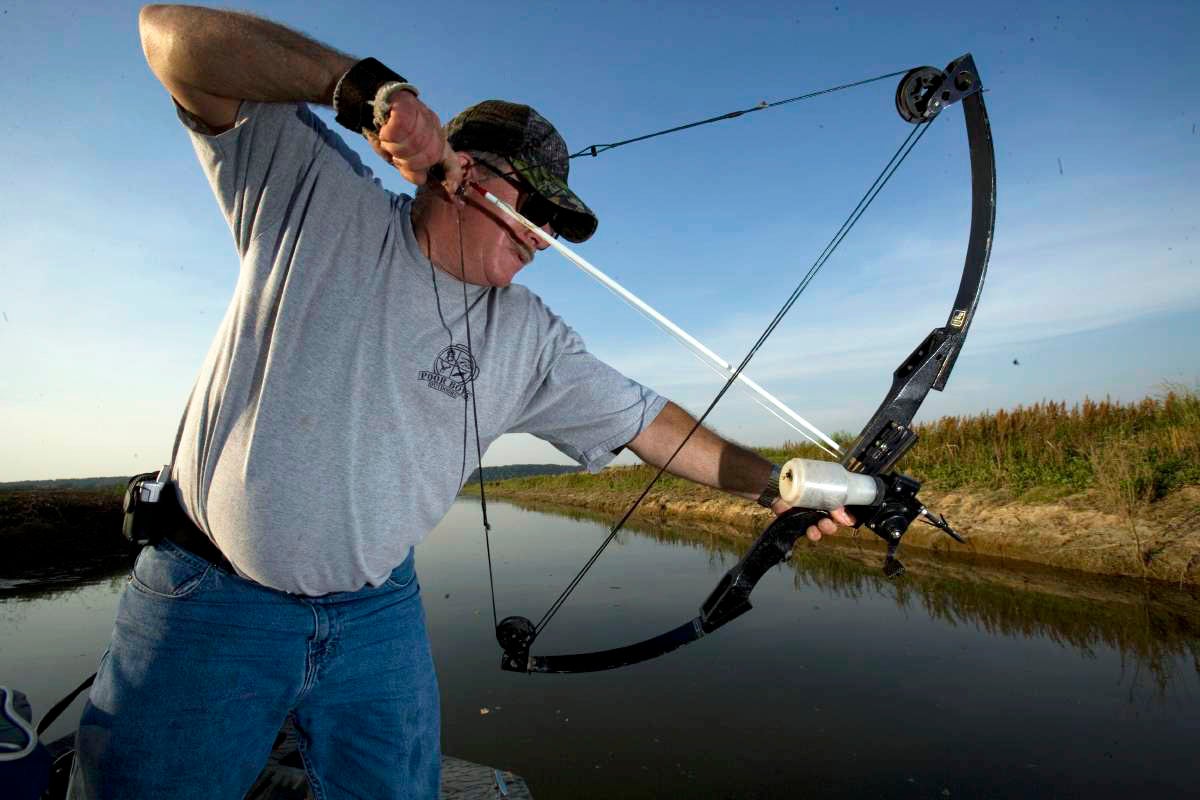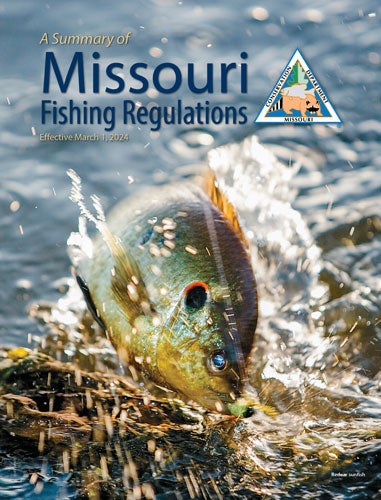About Bowfishing
Bowfishing is the pursuit of fish with a bow and arrow and is more like small game hunting than fishing. Bowfishing is a legal method for catching nongame fish, including:
- Bluegill
- Green sunfish
- Carp
- Carpsuckers
- Suckers
- Buffalo
- Drum
- Gar
- Any species not defined as game fish or listed as endangered in the Wildlife Code of Missouri
Bowfishing offers an exciting way to pursue these fish that typically draw little interest with traditional methods.

A Different Kind of Challenge
Traditional fishing uses hooks, and fish aren’t typically seen during the angler’s pursuit of them. Bowfishing is quite different in that fish are first spotted and then shot at with a bow or crossbow. The bow or crossbow shoots arrows attached to a line so that the fish can be retrieved after they’re pierced.
Because water refracts (bends) light waves, connecting with a fish is harder than you might think. The deeper the fish is in the water, the more distorted it will appear and the harder it is to tell its exact location. The angler must compensate for this refraction, making the shot more difficult. The tendency is to shoot over the fish, so learning how to adjust the shot at a moment’s notice on a moving target can prove quite tricky.
A fishing license is needed to bowfish.
Title
How to Bowfish
Fish can be successfully pursued during the day, but many people bowfish at night when fish are often more active and more visible than in the daylight.
Light
To illuminate the water at night, bowfishers traditionally hung lanterns or oil lamps over a boat’s bow. Today, halogen lights powered by a gas generator or LED lights are commonly used. Bowfishers without boats use handheld lights along the banks or other vantage points. Moonlight alone does not provide sufficient light for locating and properly identifying fish.
Moon phase and water clarity
The moon phase and water clarity play an important role in bowfishing. During a full moon, fish are typically more skittish because they feel more exposed, which can make it more difficult to get close to them. During a new moon it is often easier to get close to them as they feel more hidden in the dark. The same goes for water clarity — the clearer the water, the more difficult it can be to get close to fish even though you can see them better. The opposite is true of murky or turbid waters.
Finding fish
Because fish are pursued by sight and most legal fish are bottom feeders, slowly cruising the shores and still backwaters are generally most productive for bowfishing. Fish will typically be seen feeding in the substrate, along the shore, or just loafing. Smooth, still water is most conducive for proper fish identification and shooting; choppy water makes it more difficult. During the day, the use of polarized sunglasses reduces glare on the water and enhances visibility.
More pointers
- Staying on the move and covering a lot of water is more successful than staying in one spot.
- If your mobility is restricted, try chumming the water with soured corn, canned corn, grain and molasses pellets, dog food, or cereal to encourage fish to come to you.
- Cautiously closing the distance is the key to getting a shot, but fish can appear and disappear from anywhere in the water at any time. The action can be quite unpredictable to say the least!
Title
Bowfishing Management
Nongame fish are pursued and harvested at significantly lower rates than game fish, so their populations are typically abundant. MDC conducts some dedicated management for species like alligator gar, working to restore these fish to their former native habitat in southeastern Missouri in recent years.
Invasive species control helps to protect native fish species in Missouri waterways. These invasive species include:
- Silver carp
- Bighead carp
- Grass carp
- Common carp
- Goldfish
Regulations and other public awareness initiatives to prevent invasive species from inhabiting new waters are ongoing. Regulations permit unlimited harvest with few restrictions on these invasive species since their total eradication would be ideal.
Title
Featured Bowfishing Spots
Many conservation areas don’t support adequate nongame fish populations or an area large enough to offer ample bowfishing opportunities and therefore don’t permit bowfishing.
Access to large lakes, reservoirs, and rivers provide the best opportunity and success for bowfishing. Try large waters by way of MDC accesses, or consider one of the suggested areas below.
For more detailed information about an area, visit our Places to Go webpage.
Conservation areas
- Cooley Lake CA (Clay Co.)
- Diana Bend CA (Howard Co.)
- Duck Creek CA (Bollinger, Stoddard, Wayne Counties)
- Eagle Bluffs CA (Boone Co.)
- Four Rivers CA (Bates, Vernon Counties)
- King Lake CA (Gentry, DeKalb Counties)
- Little Compton Lake CA (Carroll Co.)
- Long Branch Lake Management Lands (Macon Co.)
- Marais Temps Clair CA (St. Charles Co.)
- Pony Express Lake CA (DeKalb Co.)
- Ted Shanks CA (Pike Co.)
Large lakes and reservoirs
- Big Lake State Park (Holt Co.)
- Lake Contrary (Buchanan Co.)
- Mozingo Lake (Nodaway Co.)
- Nodaway County Community Lake (Nodaway Co.)
Shooting a fish with an arrow is not the same as catching it with a hook. Shot fish are considered harvested and must not be returned to the water. Catch-and-release bowfishing is simply not ethical.
Nongame fish are often overlooked for the food they provide. Some restaurants serve nongame fish, and some grocery stores sell it as well.






















